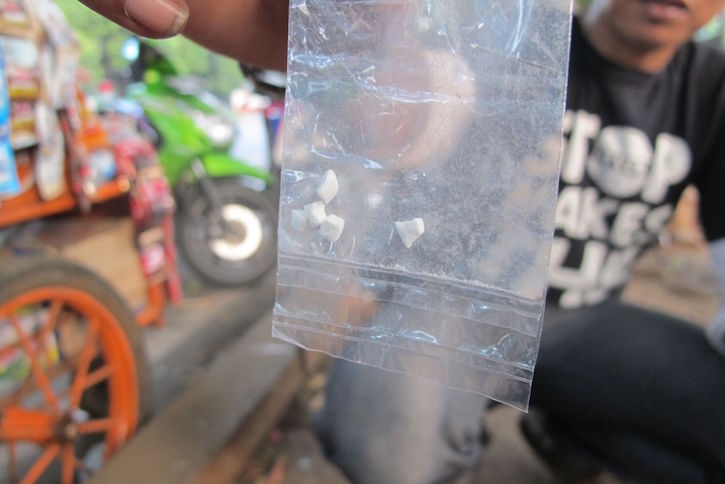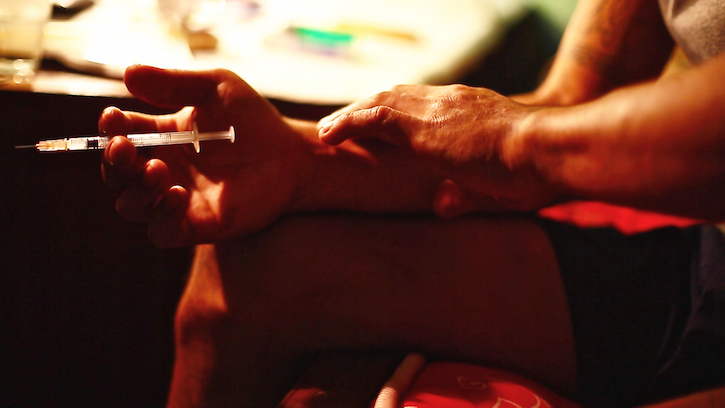Sari Damar Ratri
The first time I met Veni* she was carrying boxes of clean needles from the Centre for Health Research at the University of Indonesia. She is an outreach worker whose life has been entangled with the physical and social harms of drug use. Her first husband was a drug user who sometimes earned money from drug dealing. While he struggled with his addiction, Veni was left to find ways to provide for her family. After 15 years Veni finally ended the marriage as she felt she couldn’t be her husband’s ‘guardian angel’ any more.
The experience of coping with her ‘junkie’ ex-husband had a profound impact on Veni and in 2008 she became involved in harm reduction, a global intervention program aimed at minimising the medical and social problems associated with illegal drug use. It does this by encouraging the use of legal substitution drugs, like methadone and subuxone, and distributing free clean needles and condoms.
Veni’s involvement in harm reduction started when she was invited to give a testimonial as the wife of an injecting drug user (IDU). Soon after, she was recruited by several non-government agencies (NGOs) in Jakarta to do outreach work meeting with drug users, distributing clean needles and referring those who want access to treatment. She has found outreach work a positive way to share her experience of living with a drug user while, at the same time, earning enough money to provide for her children. Veni believes that she is not only helping drug users and their families but also helping to manage the emotional pain and trauma of her past.
Incubation period
After the first case of HIV/AIDS was identified in Bali in 1987, Indonesia started one of the largest harm reduction programs in Asia. Focusing upon one of the highest risk groups, IDUs, harm reduction has come to dominate efforts to impede the spread of HIV/AIDS. The first case of HIV transmitted via unsafe drug injection was reported in 1995, by 2005 unsafe drug injection caused 38.9 per cent of total reported cases. Some scholars believe that the number of drug users increased significantly after the fall of the Suharto regime in 1998 due to a combination of the impacts of economic collapse, high unemployment and an upsurge in social and political violence. The numbers of intravenous drug users are still growing.
Post-Suharto presidents have introduced limited measures to try and stem this. During the presidency of Megawati, for example, a memorandum of understanding was signed between the National Narcotics Board and the National AIDS Commission in response to the increasing number of IDU-related HIV cases. Methadone therapy was introduced for putau (low grade heroin) dependencies in Jakarta and Bali. In 2004, the Yudhoyono administration successfully sought international funding to create an IDU Intervention Unit which managed 22 NGOs and two Health Ministry programs across six provinces. By the end of 2006, a decree from the Ministry of Health had established guidelines for harm reduction implementation. The government's support for methadone therapy programs was also reflected in subsidies and the establishment of methadone treatment in some community health centres.
Despite these measures, studies examining harm reduction implementation in Indonesia have identified significant gaps between rhetoric and practice. Perhaps most alarmingly, instead of reducing addiction as intended, harm reduction measures have often resulted in new poly-drug dependencies involving combinations of prescribed substitution drugs. Lack of adequate information and supervision has made it harder for IDUs to manage substitution drug use while struggling with their dependencies to illegal drugs. Many IDUs are using both methadone and anti-depressants – mostly without supervision of a doctor – in order to achieve their desired physical and mental states. This is prohibited within the treatment regime as harm reduction, in order to be successful, demands that only methadone is used.
High-risk moment
Veni and her friend Maulana* started talking about these impacts of harm reduction implementation during an outreach annual meeting in December 2014. The conversation began from their shared pessimism regarding what’s been achieved to date and what still needs to be done. ‘What is harm reduction really trying to accomplish? We have been doing this work for more than ten years, but drug users are still vulnerable’ said Veni. Despite harm reduction programs having run for so long there remains a lack of basic support services for drug users.
The main focus of current harm reduction programs is the distribution of clean needles for IDUs. This is related to the government’s national action plan that at least 30 per cent of the country’s IDUs should have access to substitution drugs, and 70 per cent should have access to sterile needles. However, another important goal of the harm reduction program – to improve the socio-economic conditions of IDUs’ – continues to receive little attention and few resources.
IDUs face a number of difficult challenges in finding work and participating in treatment programs creates further impediments as most treatments are held during office hours. Providing take-home doses has been used as one means of overcoming this problem; however, difficulty in finding and keeping regular employment is part of a vicious cycle for IDUs participating in harm reduction programs.

Uncertainty over job security and the sustainability of existing programs has also been felt by outreach workers. The HIV Cooperation Programme in Indonesia – Australia Aid (or HCPI–AusAid) has been the largest financial support body for harm reduction; however, funding ended in December 2015. Veni and Maulana are unsure about what the future holds. ‘We don’t know anything yet, all we know is that we can still work until October’ said Veni. Maulana is more sceptical. ‘Without HCPI–AusAid, NGOs won’t be able to continue distributing clean needles in Jakarta. Even the syringes for the harm reduction program in community health centres are provided by HCPI–AusAid.’
The benefits of clean needle distribution are limited not only by the termination of HCPI–AusAid funding but also by the current Indonesian government’s steadfast adherence to a ‘zero tolerance’ policy towards illegal drug use. Many injectors are reluctant to carry clean needles with them for fear that police would treat it as proof that they use illegal drugs. Thus, HIV prevention programmes for IDUs are at risk because clean needles are no longer distributed in user hot spots.
Although the National AIDS commission still has stocks of syringes that can be used as a buffer, these are said to be of low quality. Some users even prefer to use second-hand syringes. Taufan*, a subuxone user, said ‘the pistons of syringes from the AIDS commission are easily broken. They are useless for IDUs’. President Widodo may have declared a national ‘Darurat Narkoba’ (Drug Emergency), but this has not included the provision of necessary basic supports for drug users.
With the HCPI–AusAID coming to an end, the availability of syringes for IDUs is now at stake. Most financial support for programs delivered by community health centres comes from the national budget through the Ministry of Health, and this is likely to be delayed due to a convoluted bureaucracy. According to Presidential Decree No. 12/2013 regarding health insurance, treatment for HIV/AIDS patients will continue to be provided, with the exception of drug-related therapy. However, with minimal financial support from the government for syringe exchanges and institutionalised discrimination against drug users affecting their access to adequate health care, Indonesia is likely to face greater problems.
Indonesia’s current drug policy still puts many users through the criminal justice system, with harm reduction based in a total abstinence paradigm implemented by poorly-resourced rehabilitation centres. In spite of this, the National Narcotic Board declared that it would rehabilitate 100 000 drug users by the end of 2015. It is not surprising, considering the lack of sufficient infrastructure, resources and qualified staff to run existing rehabilitation centres, that this target was not reached. Moreover, it reflects the government’s continued misunderstanding of the nature of addiction itself, which cannot be adequately addressed while drug users continue to be criminalised.
In the words of Taufan, ‘Indonesia doesn’t really have any disaster preparedness; all we’re doing is fighting against the fire. By the end of the day, it’s all too late.’ Does this mean we should say good-bye to Indonesia’s target of zero new HIV cases by 2030?
*Not their real names.
Sari Damar Ratri (sdratri@ekuator.or.id) is a medical anthropologist at Yayasan Ekuator, a research foundation that focuses on the study of inequality and marginalisation in Indonesia. She is currently working as media-communication manager at the Centre for Gender and Sexuality Studies, Faculty of Social and Political Sciences, University of Indonesia. Her research on harm reduction implementation in Indonesia was part of the University of Amsterdam’s Chemical Youth Project funded by European Research Council (ERC).
Inside Indonesia 124: Apr-Jun 2016{jcomments on}
